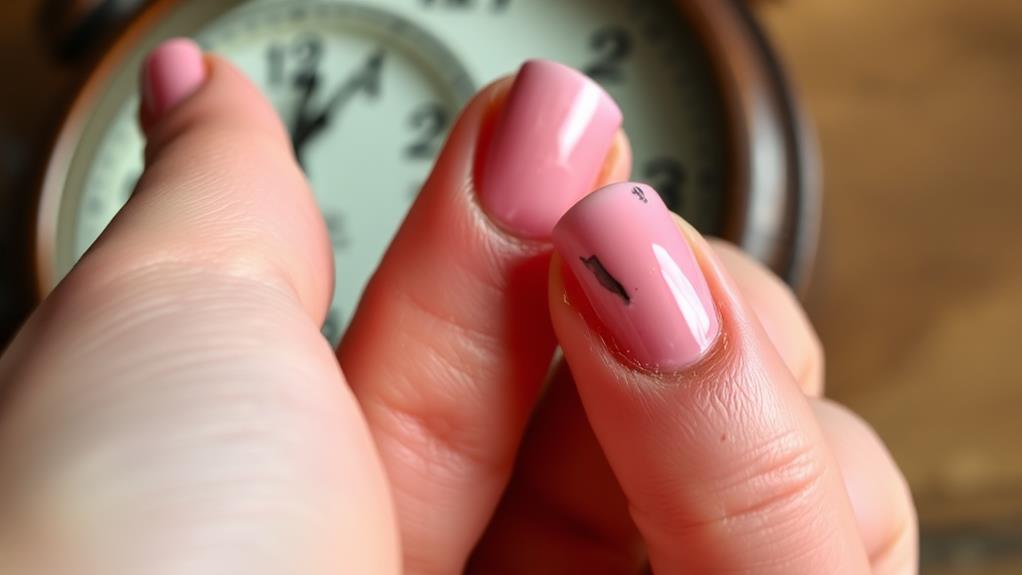You've just applied your nail polish, but have you considered what happens to your body ten hours later? As the hours tick by, harmful chemicals like triphenyl phosphate quietly seep into your bloodstream, potentially causing hormonal shifts and respiratory issues. You might even start noticing skin irritation or other allergic reactions, especially if you're sensitive. These immediate effects raise important questions about the long-term implications of these chemicals. What exactly does this mean for your health, especially if you use nail polish frequently? The answer might surprise you.
Health Risks of Nail Polish
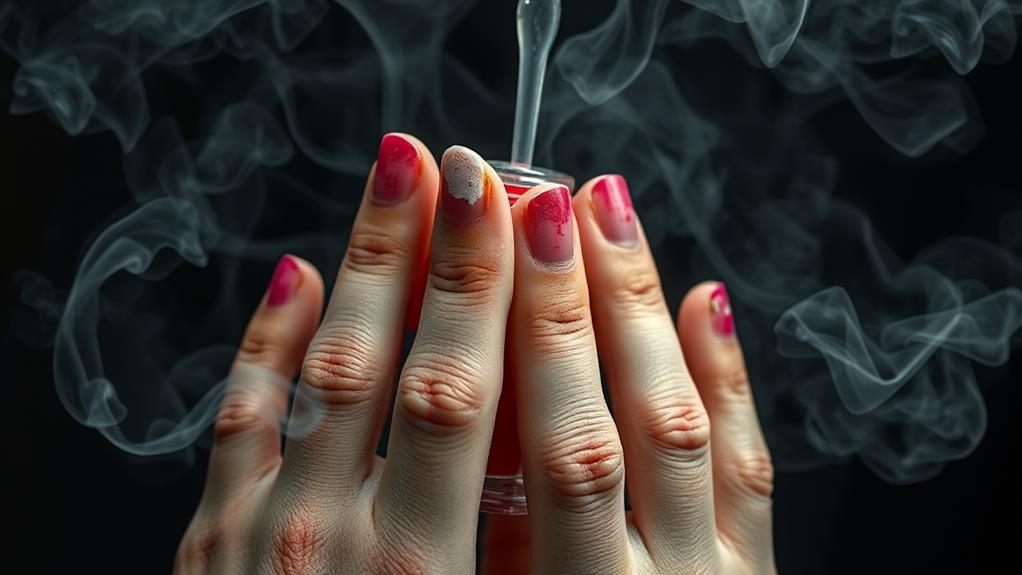
When you reach for that bottle of nail polish, you mightn't realize the hidden dangers lurking inside. Sure, that shiny color looks fabulous, but many nail polishes contain chemical toxins that can pose serious health risks.
Ingredients like formaldehyde and dibutyl phthalate aren't just scary names; they can affect your central nervous system and lead to reproductive disorders. Yikes!
Imagine this: just ten hours after applying your favorite polish, levels of diphenyl phosphate, a toxic byproduct, can skyrocket in your body. You could even experience dermatitis, which sounds fancy but really just means your skin might get all red and itchy.
And let's not forget, formaldehyde can cause severe allergic reactions, making you wish you'd stuck to plain nails.
That's why consumer awareness is super important. When shopping for nail polish, look for "3-free" or "5-free" labels.
These products exclude the most harmful ingredients and can keep your nails looking great without the nasty side effects.
Toxic Ingredients to Avoid
If you want to keep your nails looking fabulous without compromising your health, it's important to steer clear of certain toxic ingredients found in many nail polishes. You might be surprised to learn that some common chemicals can have nasty effects on your body.
For example, formaldehyde, often lurking in nail polish, is a known carcinogen. It can cause respiratory problems and skin irritations, making it a serious no-no!
Another culprit is dibutyl phthalates (DBP), which many nail polishes use for their flexibility. Unfortunately, DBP has been linked to issues with the reproductive system and can mess with your hormones. Yikes!
You should also be wary of toluene, a chemical that can lead to headaches and dizziness, and triphenyl phosphate (TPHP), which may cause endocrine disorders and weight gain.
Repeated exposure to these toxins can even lead to dermatitis and other skin problems.
Chemical Absorption Process
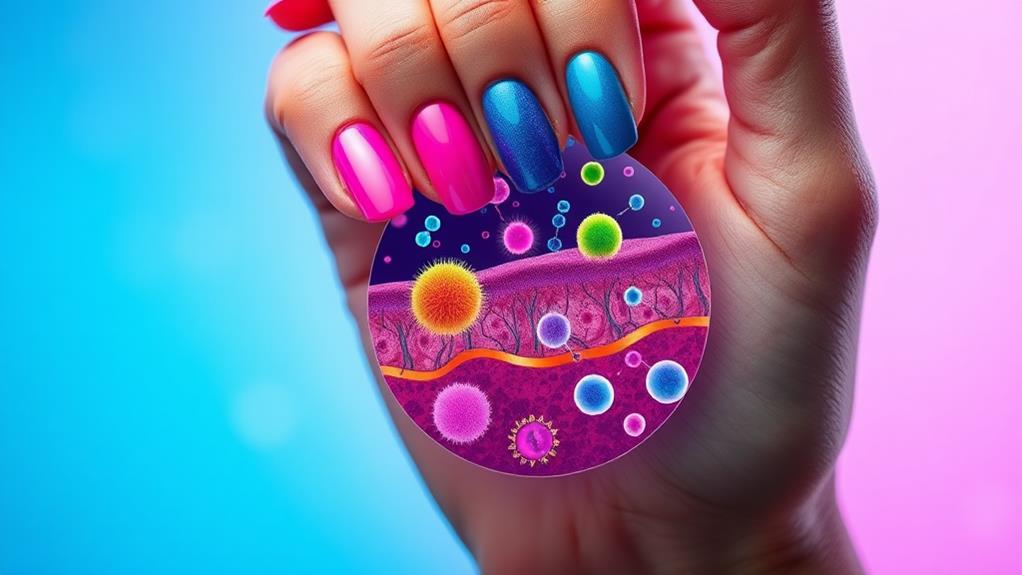
Many people don't realize how quickly chemicals from nail polish can enter your body after application. When you paint your nails, those toxic ingredients, like triphenyl phosphate (TPHP), start a sneaky journey through your skin.
Studies show that, within just 10 hours, levels of diphenyl phosphate in women can jump up to seven times the normal amounts! That's some serious chemical absorption happening right beneath the surface.
While your fingernails are pretty tough, they can still allow harmful substances to seep in, especially if they're weak. This means that any chemicals absorbed through your skin can make their way into your bloodstream. Yikes! It raises some big questions about the long-term health effects of these toxic ingredients.
Not everyone absorbs these chemicals the same way, though. Individual differences in skin permeability and health status can make a difference in how much these substances get in.
Effects on Hormonal Balance
Applying nail polish might seem like a fun way to express your style, but it can have serious implications for your hormonal balance. After about ten hours, a chemical called triphenyl phosphate (TPHP) can increase in your body. This chemical is linked to endocrine disruption, which means it can mess with your hormones.
When your hormones are out of whack, it can affect your metabolism and reproductive health. You mightn't realize it, but TPHP can change your thyroid hormone levels. This change can lead to metabolic issues, like weight gain, which is something nobody wants.
Prolonged exposure to other chemicals in nail polish, like dibutyl phthalate, can also make reproductive health problems worse, especially in young girls.
Even more surprising, studies show that levels of diphenyl phosphate can build up in women after using nail polish. This buildup can cause more problems for your hormonal balance over time.
Immediate Reactions to Application
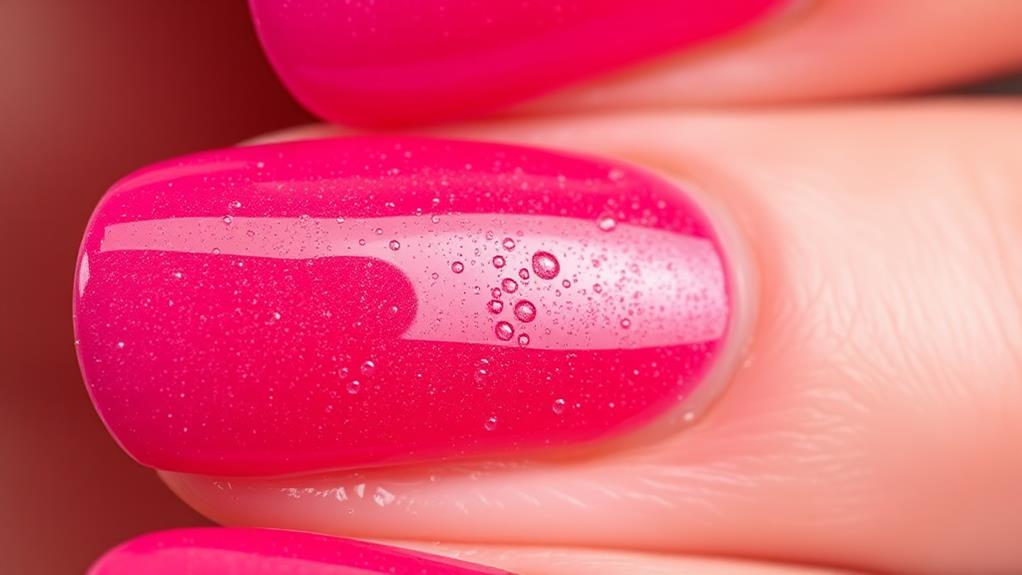
Additionally, the volatile organic compounds, or VOCs, released from nail polish can lead to respiratory issues, making it hard to breathe comfortably, especially in a poorly ventilated area.
And did you know that in just a few hours, elevated levels of diphenyl phosphate, a toxic component, can show up in your body?
This can be a little alarming, but it's good to know.
Long-Term Health Implications
The long-term health implications of using nail polish can be concerning, especially when considering the harmful chemicals often found in these products. You might love to flaunt your fabulous nails, but did you know that regular nail polish use can lead to some nasty side effects? Chronic exposure to chemicals like toluene and formaldehyde can cause respiratory problems and even raise cancer risks. Yikes!
Repeated use can also mess with your endocrine system, leading to hormonal imbalances and reproductive disorders. A study found that after just ten hours of applying nail polish, levels of diphenyl phosphate increased dramatically, showing how quickly your body absorbs these chemicals. This means the potential for cumulative health implications over time is real.
It doesn't stop there—regular polish application can cause skin irritation, dermatitis, and allergic reactions too. If you're pregnant or have pre-existing health conditions, the effects can be even worse.
Research Findings on TPHP
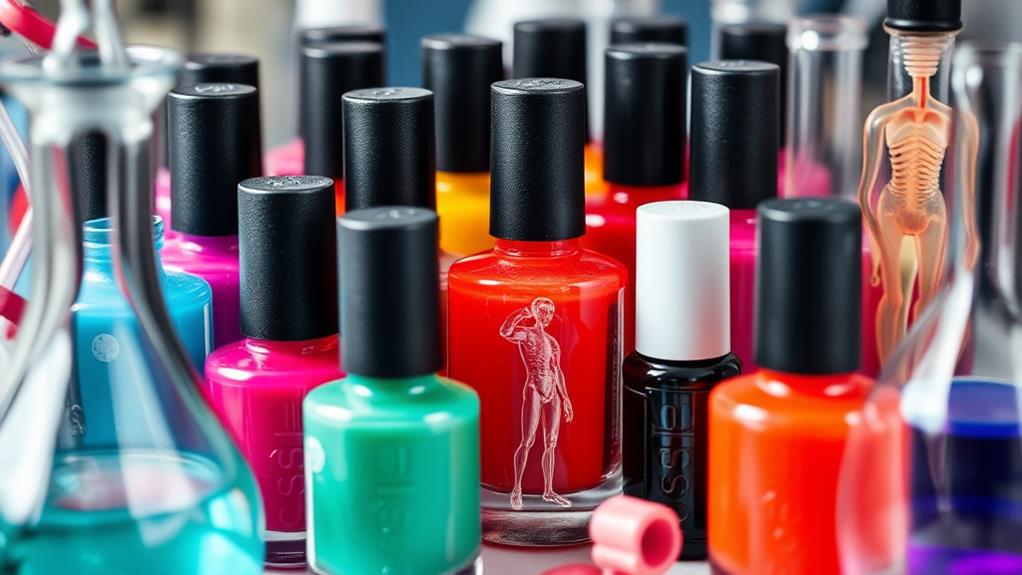
Nail polish might make your nails look stunning, but research shows it can introduce some concerning chemicals into your body. One of the main culprits is triphenyl phosphate, or TPHP.
A study found that after applying nail polish, TPHP showed up in the urine of all 26 participants within 10 to 14 hours. That's right! Your body absorbs this chemical pretty quickly. In fact, some participants had diphenyl phosphate levels rise up to seven times higher than normal!
You might be surprised to learn that about 1,500 out of 3,000 nail polish products contain TPHP, making it a common ingredient in nail care.
But why should you care? TPHP is linked to endocrine disruption, which means it could mess with hormone regulation and metabolic processes in your body. This is particularly concerning for frequent users of nail polish.
With questions swirling around the long-term health effects of TPHP, experts are calling for more research.
Safer Nail Polish Alternatives
If you're concerned about the chemicals in traditional nail polish, safer alternatives are available that can keep your nails looking great without the risks. You might want to check out "3-Free" and "5-Free" nail polishes. These options ditch harmful ingredients like toluene, formaldehyde, and dibutyl phthalate, commonly found in regular formulas.
Non-toxic brands like Acquarella, SpaRitual, and Honeybee Gardens offer vibrant colors and peace of mind, too!
Water-based nail polishes are another fantastic choice. They skip the harmful solvents and chemicals that can pose health risks.
Plus, with growing consumer demand for safer nail products, many brands are reformulating their polishes to exclude toxic ingredients. This highlights the importance of checking ingredient labels before you buy.
It's like a treasure hunt for your nails!
Tips for Healthier Nail Care
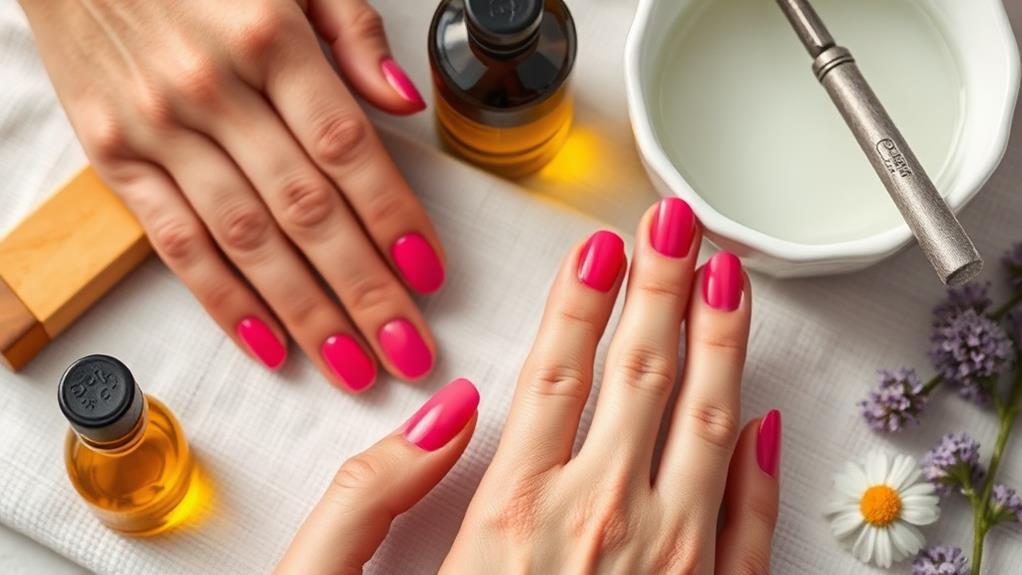
How can you guarantee your nails stay healthy while still enjoying nail polish? First, choose "3-free" or "5-free" options. These polishes skip harmful chemicals like toluene, formaldehyde, and dibutyl phthalate. That way, you're minimizing health risks while looking fabulous!
Always check the labels for any hidden toxic ingredients—studies show that 20% of nail polishes might've sneaky substances not listed.
Give your nails a break from polish every now and then. This allows time for recovery and keeps them hydrated, helping to ward off dehydration and pesky fungal infections.
And don't forget about base coats! Using them creates a barrier that can limit harmful chemicals from being absorbed into your nails.
Stay informed about health-conscious formulations and brands that care about your well-being. You can enjoy nail care without worrying too much!
Consumer Awareness and Safety
Consumer awareness plays an essential role in ensuring safety when it comes to nail products. It's super important for you to know what's in your nail polish! A study showed that chemical absorption can increase levels of certain chemicals, like diphenyl phosphate, up to seven times after just ten hours. Yikes!
You should definitely check for harmful ingredients, like toluene, formaldehyde, and dibutyl phthalate. These can lead to serious health risks over time, including gynecological diseases. That's why you want to look for safer options—like 3-Free and 5-Free formulas.
Did you know that around 1,500 out of 3,000 nail products contain triphenyl phosphate (TPHP)? That's a lot! It's vital to read those labels before you buy.
And guess what? Advocating for better regulations and choosing non-toxic alternatives can really help improve public health. When you make informed choices, you support a trend toward safer nail care products.

